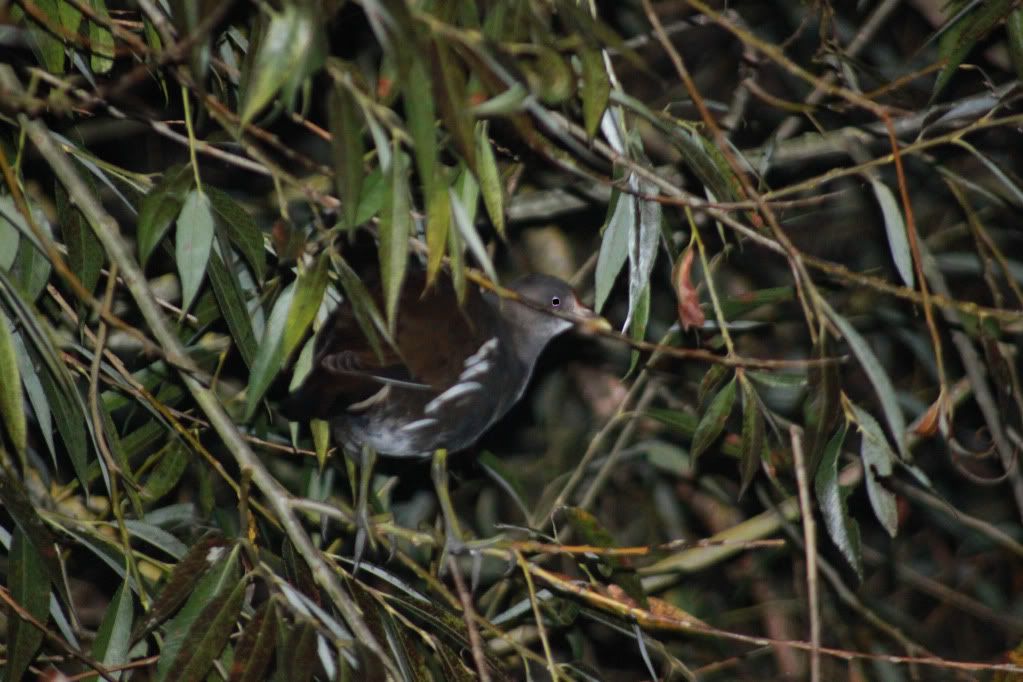Along the cycle path between Abingdon and Oxford the hawthorn bushes are now full of berries. Shortly they will be consumed by the redwings and fieldfares which will soon be arriving from Northern Europe.
Until then, the native small birds are making the most of them, goldfinches, blue tits, great tits and this flock of long tailed tits:
.
.
Wildlife and other things of interest on and around the river Ock in south Oxfordshire
Monday, 31 October 2011
Sunday, 23 October 2011
More signs of autumn
The recent dark and cold evenings mean the opportunities for wildlife watching on the river get reduced by the day and the chances of seeing water vole, an otter or a kingfisher become virtually impossible (although the chances of seeing an otter are very low at the best of times). Even so, the occasional muntjac deer stumble into view - even if it requires a high ISO and slow shutter speed.
.
.
However, autumn does provide other opportunities for the wildlife enthusiast in Oxfordshire. There are many sites which are just abundent in Fungus, including what seems to be a parasol mushroom growing at Harcourt Arboretum.
.
.
It's not just woods where fungus can be found, this 'Dead Man's Fingers' is growing in our garden. It can be differentiated from the similar looking 'Dead Moll's Fingers' by bending the stem, which breaks (rather than bouncing back).
Whilst a lot of fungus only produce their fruiting bodies in autumn, this one can be found all year at the base of dead wood, but it has taken the seasonal clearance of the garden to find it.
.
.
Over at Otmoor, the starling murmurations are just starting and although they are not yet near the vast numbers that can congregate there, it is still an impressive sight on a cold autumn evening:
.
.
.
However, autumn does provide other opportunities for the wildlife enthusiast in Oxfordshire. There are many sites which are just abundent in Fungus, including what seems to be a parasol mushroom growing at Harcourt Arboretum.
.
.
It's not just woods where fungus can be found, this 'Dead Man's Fingers' is growing in our garden. It can be differentiated from the similar looking 'Dead Moll's Fingers' by bending the stem, which breaks (rather than bouncing back).
Whilst a lot of fungus only produce their fruiting bodies in autumn, this one can be found all year at the base of dead wood, but it has taken the seasonal clearance of the garden to find it.
.
.
Over at Otmoor, the starling murmurations are just starting and although they are not yet near the vast numbers that can congregate there, it is still an impressive sight on a cold autumn evening:
.
Tuesday, 18 October 2011
Views of Brownsea Island
Situated in Poole Harbour and owned by the National Trust, Brownsea Island, only two miles across it is home to wildlife that just can't be found in such proximity in the rest of the country.
There is a breeding population of sika deer - they have not established themselves like the more common roe & muntjac deer and can be quite hard to find on the island (apparently, they wait for the day trippers to leave and then congregate by the church).
.
There is a breeding population of sika deer - they have not established themselves like the more common roe & muntjac deer and can be quite hard to find on the island (apparently, they wait for the day trippers to leave and then congregate by the church).
.
.
A completely different creature can be found on only one wall on the island and is only 5mm long. The snail Papillifera bidens (it has no common name) is common in southern europe, yet can only be found in one other location in the UK - clivedon house in Buckinghamshire
It is believed it was accidently introduced by a previous owner who imported statues from Greece.
.
.
Whilst the island is owned by the National Trust, half of it is leased to the Dorest Wildlife Trust who manage the lagoons, which are a haven for wading birds. Including avocets (the symbol for the RSPB). Once extinct in the UK as a breeding bird, it has now reestablished itself (there are now 800 breeding birds) although feeding sites are still scarce
.
.
But the animal which Brownsea is famous for - and which most people come to see - is the red squirrel. Extinct from the south of England and struggling elsewhere, there is a stable population of about 250 animals - helped by the lack of prediators and the absence of the grey squirrel - and autumn is the best time to see them as the trees start to loose leaves and as they bury nuts:
.
Thursday, 6 October 2011
Moorhens
Moorhens are so common on the rivers in Abingdon that they are often taken for granted, yet they can be somewhat difficult to photograph, they quickly sense the slightest movement and scamper into the undergrowth.
.
Perhaps one of the reasons they have survived is when it starts to get dark they group together and slowly climb up the over hanging willow trees, safely out of the way of any passing otter.
.
.
Maybe the moorhens shouldn't be too complacent - apparently otters can climb trees as well: http://news.bbc.co.uk/local/gloucestershire/hi/people_and_places/nature/newsid_8468000/8468065.stm
.
.
.
Even though they a favourite food of otters, it has been a good breeding year with several young moorhen now finding their independence.Perhaps one of the reasons they have survived is when it starts to get dark they group together and slowly climb up the over hanging willow trees, safely out of the way of any passing otter.
.
.
Maybe the moorhens shouldn't be too complacent - apparently otters can climb trees as well: http://news.bbc.co.uk/local/gloucestershire/hi/people_and_places/nature/newsid_8468000/8468065.stm
Subscribe to:
Comments (Atom)












